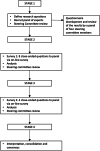Task Force Consensus on Nosology and Cut-Off Values for Axial Postural Abnormalities in Parkinsonism
- PMID: 35844289
- PMCID: PMC9274349
- DOI: 10.1002/mdc3.13460
Task Force Consensus on Nosology and Cut-Off Values for Axial Postural Abnormalities in Parkinsonism
Abstract
Background: There is no consensus with regard to the nosology and cut-off values for postural abnormalities in parkinsonism.
Objective: To reach a consensus regarding the nosology and cut-off values.
Methods: Using a modified Delphi panel method, multiple rounds of questionnaires were conducted by movement disorder experts to define nosology and cut-offs of postural abnormalities.
Results: After separating axial from appendicular postural deformities, a full agreement was found for the following terms and cut-offs: camptocormia, with thoracic fulcrum (>45°) or lumbar fulcrum (>30°), Pisa syndrome (>10°), and antecollis (>45°). "Anterior trunk flexion," with thoracic (≥25° to ≤45°) or lumbar fulcrum (>15° to ≤30°), "lateral trunk flexion" (≥5° to ≤10°), and "anterior neck flexion" (>35° to ≤45°) were chosen for milder postural abnormalities.
Conclusions: For axial postural abnormalities, we recommend the use of proposed cut-offs and six unique terms, namely camptocormia, Pisa syndrome, antecollis, anterior trunk flexion, lateral trunk flexion, anterior neck flexion, to harmonize clinical practice and future research.
Keywords: Parkinson's disease; Pisa syndrome; antecollis; atypical parkinsonisms; camptocormia; diagnostic criteria.; postural abnormalities.
© 2022 The Authors. Movement Disorders Clinical Practice published by Wiley Periodicals LLC. on behalf of International Parkinson and Movement Disorder Society.
Figures





Similar articles
-
Assessment of Axial Postural Abnormalities in Parkinsonism: Automatic Picture Analysis Software.Mov Disord Clin Pract. 2023 Feb 20;10(4):636-645. doi: 10.1002/mdc3.13692. eCollection 2023 Apr. Mov Disord Clin Pract. 2023. PMID: 37070056 Free PMC article.
-
Diagnostic criteria for camptocormia in Parkinson's disease: A consensus-based proposal.Parkinsonism Relat Disord. 2018 Aug;53:53-57. doi: 10.1016/j.parkreldis.2018.04.033. Epub 2018 May 8. Parkinsonism Relat Disord. 2018. PMID: 29759930 Free PMC article.
-
Dynamic Video Assessment of Axial Postural Abnormalities in Parkinson's Disease: A Pilot Study.Mov Disord Clin Pract. 2025 May;12(5):626-637. doi: 10.1002/mdc3.14329. Epub 2025 Jan 29. Mov Disord Clin Pract. 2025. PMID: 39878647 Free PMC article.
-
Predictors and Pathophysiology of Axial Postural Abnormalities in Parkinsonism: A Scoping Review.Mov Disord Clin Pract. 2023 Sep 25;10(11):1585-1596. doi: 10.1002/mdc3.13879. eCollection 2023 Nov. Mov Disord Clin Pract. 2023. PMID: 38026508 Free PMC article.
-
Postural deformities in Parkinson's disease.Lancet Neurol. 2011 Jun;10(6):538-49. doi: 10.1016/S1474-4422(11)70067-9. Epub 2011 Apr 22. Lancet Neurol. 2011. PMID: 21514890 Review.
Cited by
-
Reply: "Human Pose Estimation Is Approximate: Limitations and Considerations for its Use in Clinical Trials".Mov Disord Clin Pract. 2025 Aug;12(8):1216-1217. doi: 10.1002/mdc3.70075. Epub 2025 Apr 12. Mov Disord Clin Pract. 2025. PMID: 40219769 Free PMC article. No abstract available.
-
[Numerical expression of the clinical course of the disease. Data management].Rev Med Inst Mex Seguro Soc. 2023 Oct 2;61(Suppl 3):S503-S509. doi: 10.5281/zenodo.8319834. Rev Med Inst Mex Seguro Soc. 2023. PMID: 37935026 Free PMC article. Spanish.
-
Spinal cord stimulation for postural abnormalities in Parkinson's disease: 1-year prospective pilot study.BMC Neurol. 2024 May 21;24(1):167. doi: 10.1186/s12883-024-03673-5. BMC Neurol. 2024. PMID: 38773417 Free PMC article.
-
Botulinum Toxin for Axial Postural Abnormalities in Parkinson's Disease: A Systematic Review.Toxins (Basel). 2024 May 15;16(5):228. doi: 10.3390/toxins16050228. Toxins (Basel). 2024. PMID: 38787080 Free PMC article.
-
Five functional domains associated with gait performance in Parkinson's disease and lateral trunk flexion.Front Neurol. 2025 Apr 8;16:1541970. doi: 10.3389/fneur.2025.1541970. eCollection 2025. Front Neurol. 2025. PMID: 40264652 Free PMC article.
References
-
- Doherty KM, van de Warrenburg BP, Peralta MC, Silveira‐Moriyama L, Azulay JP, Gershanik OS, Bloem BR. Postural deformities in Parkinson's disease. Lancet Neurol 2011;10:538–549. - PubMed
-
- Barone P, Santangelo G, Amboni M, Pellecchia MT, Vitale C. Pisa syndrome in Parkinson's disease and parkinsonism: clinical features, pathophysiology, and treatment. Lancet Neurol 2016;15:1063–1074. - PubMed
LinkOut - more resources
Full Text Sources

